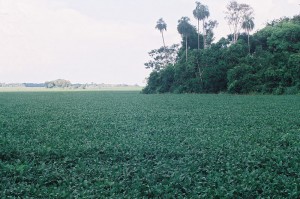By Jonathan Gilbert / Santa Catalina, Paraguay Aug. 09, 2013
Emilio Arce lives in fear of the soy plantations that edge ever closer to his home in eastern Paraguay, the landlocked nation’s heartland of grain production. “They’re just seven miles away now,” he says. Arce, 54, is a subsistence farmer in the province of Caaguazú, where he sows manioc, red corn and beans. But his livelihood is under threat. Thousands of communities across rural Paraguay claim their lands are being poisoned by the expansion of genetically modified (GM) soy. And with the inauguration of newly-elected president Horacio Cartes, a right-wing businessman, this month, government policies are expected to favor soy farmers and further imperil campesinos, the people of the countryside.
Paraguay is the world’s fourth biggest exporter of soy, a crop that has been dubbed “green gold.” Its harvest – likely to reach a record 8.4 million tonnes this season – is mostly shipped as raw soybeans to the European Union, where it is used in cattle feed, or to Argentina for the manufacture of biofuels. More than three million hectares of soybean are currently sown in Paraguay, nearly triple the area in 1998, and agricultural exports will account for the majority of the country’s predicted 13 percent GDP growth this year. But the success of soy and Paraguay’s agroexport model has come at a cost.
A few miles from Arce’s home lies the small village of Santa Catalina, surrounded by a gold sea of harvested soy. The 500 villagers no longer drink from the stream that sustained them for two decades. It’s too polluted. They blame the contamination on the Mennonite owners of an adjacent farm, who fumigate their GM crops with herbicides every four months.
Alodia Noguera, 55, has acne on her legs that is so severe she struggles to walk. Others also complain of illnesses. “I have gastritis and chronic migraines,” says Elvio Meza, 35, holding up an X-ray of his stomach in his home, which has an adobe floor. The community attributes their various symptoms to the agrochemicals, though there has yet to be clear scientific or medical confirmation of their specific claims. Thousands of villages across Paraguay are fighting a similar battle. In many cases, people simply leave. Around 9,000 families a year in a nation of fewer than 7 million people migrate from the countryside to cities because of soy monoculture, according to BaseIS, an Asunción-based social research center. “Peasants are displaced because they are being poisoned,” says Óscar Rivas, a former environment minister.
Dionisio Gómez moved to Asunción in 1998 because the water in Campo Agua’e, his village in the state of Canindeyú, was contaminated. “They would fumigate the soy and the chemicals infiltrated our land,” says Gómez, who now lives in a slum. Two of Gómez’s children were stillborn with defects. Doctors never gave a cause, but academic studies — including a 2008 paper on Paraguay published by the American Academy of Pediatrics — say herbicides, specifically glyphosate, cause birth malformations.
Monsanto, the multinational that first brought glyphosate to market, says on its Paraguayan website that none of the studies are “serious.” Responding to TIME, the company also pointed to other papers that conclude glyphosate is non-carcinogenic. “When applied and used correctly, glyphosate does not have adverse effects on human health,” Monsanto South Latin America said in an email. It added that all of its products include guidelines for responsible use and that, in the last year, it has trained more than 4,000 farmers across Paraguay, Argentina, Chile, Uruguay and Bolivia in good practice.
But a government requirement designed to give campesinos additional protection is rarely respected, says Alicia Amarilla of peasant rights organization CONAMURI. A 2004 presidential decree says there must be a distance of 50 meters between fumigated plantations and villages, or a dense “foliage barrier” that is five-meters wide. In Santa Catalina, the line of eucalyptus trees that separates the community from the soy farms does not reach five meters across.
Under Fernando Lugo, Paraguay’s first left-wing leader in six decades, global agrochemical companies were made to respect a rigorous testing process before they could commercialize new strains of genetically modified seeds. But after Lugo was ousted in a parliamentary coup in June 2012, the government of his successor, Federico Franco, fast-tracked the approval of seven GM soy, cotton and corn strains, in one case by presidential decree. Lugo believes that is a sign agrochemical companies played a role in his impeachment. “Multinationals acted from the shadows in the coup against me,” Lugo, who is set to become a senator in the parliament’s opposition, tells TIME. Lugo was removed from office for “poor performance of his duties” days after a fatal conflict between peasants and police. The peasants had occupied land they say was illegally sold to a late senator in Cartes’ Colorado party during the 1954-89 dictatorship of Alfredo Stroessner. They refer to such lands as malhabidas, or ill-gotten.
Monsanto, whose Roundup Ready soybean is present in 95 percent of Paraguay’s production, was authorized to sell its new strain of GM soy to farmers just seven months after Franco was sworn in. But the company claims it did not view Lugo’s overthrow as the removal of a barrier to expansion. “Rhetoric aside, the reality is that the governments of Lugo and Franco followed the same line [with regard to GM seeds],” says Pablo Vaquero, vice-president of Monsanto South Latin America. “There was no difference.”
Soy was first cultivated for export in Paraguay in the 1970s and small-scale farmers have gradually been pushed out by big landowners, many from neighboring Brazil. Campesinos that resist soy expansion are the subject of “targeted assassinations and surgical terror that disarticulate their political networks,” says Kregg Hetherington, an anthropologist at Dalhousie University in Canada and author of the book Guerrilla Auditors, about peasant land struggles in Paraguay.
In December, one of the leaders of the peasant movement involved in the dispute that led to Lugo’s impeachment was gunned down in Canindeyú by two unidentified men on a motorbike. Since 1989, more than 120 peasants have been murdered in the fight against soy monoculture, says Barcilio Ruis Martínez, the president of an association for small-scale farmers based in Asuncion. Their contribution to Paraguay’s agricultural production fell from 70 percent in 1991 to 32 percent in 2008, according to Oxfam.
“Mass soybean cultivation will continue to expand,” says Walter Pengue, an Argentine professor of economic ecology. “In Latin America, the area of land used for grain production over the next 20 years will increase by 40 percent more than the world average.” Soy exports in Paraguay, however, are untaxed and nearly a third of the country lives below the poverty line. Unequal land distribution — a historic problem that fuels social ills and political turmoil across the continent — is deepening. Today, more than 80 percent of land is controlled by two percent of the population.
Cartes won April’s election with a populist message that appealed to peasants. “I promise there will be no more fighting over land,” he said in a campaign speech in Canindeyú.
But analysts predict he will give his full backing to Paraguay’s agroexport model. “The Cartes government will give the soy sector free rein,” says Hetherington. “The tacit understanding we saw between Franco and the farmers will deepen. There will be more conflict.” Germán Rojas, who leads the president-elect’s transition team, has indicated Cartes will not support a bill for a 10 percent grain exports tax — a position described as “good for the country” by Héctor Cristaldo, head of Paraguay’s main agroindustry organization. But the transition team told TIME that he may back a tax on producers’ earnings.
Asked if Paraguay’s new government would recognize the claims of Santa Catalina’s peasants, the transition team’s responded with a recognition that the “rural sector has not been dealt with integrally for many years,” referring to the widening disparity between the success of agrobusiness and the struggles of small-time farmers. It said access to technology and technical assistance are campesinos’ most pressing needs.
In Caaguazú, Emilio Arce looks beyond his allotment to the soy fields. “We’re scared our crops will die and that we’ll become ill,” he says. “But GM is big business and politicians here are under pressure. We’ll resist for as long as we can.”

